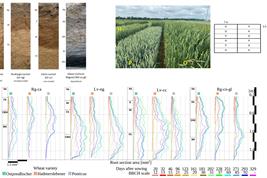27.10.2025

Plant carbon input into agricultural soils plays a decisive role in soils’ carbon content (%) and carbon mass (kg m-2) and thus in the CO2 source and sink effect of soils. While this relationship has been very well researched for topsoils (0-30 cm), there are considerable gaps in our knowledge of subsoils (> 30 cm), which stores 36% of the total carbon in agricultural soils in Germany.
As part of the DFG project ‘TilEro’, the extent to which historical wheat cultivars differ from modern cultivars in terms of their carbon input was investigated along a full erosion-deposition gradient. One focus was on the previously little-studied root dynamics in subsoils, which were recorded over an entire vegetation period using rhizotrons.
Our study confirms the well-known effect of higher grain yields from modern cultivars. However, this was strongly dependent on the degree of soil erosion. The modern cultivar
Ponticus produced up to 70% more grain than older varieties on colluvial soils, but only 30% more on heavily eroded soils. However, the higher yields of
Ponticus were accompanied by reduced amounts of straw and roots. This led to a significant reduction in carbon input: by 32% in heavily eroded soils and by 43% in colluvial soils. The combined effect of severe erosion and modern varieties resulted in a reduced carbon input of 3.2 t C ha−1 year−1, of which 0.6 t originated from the roots in the subsoil. The oldest variety (Ostpreussischer Eppweizen, 1910), on the other hand, produced 50% more straw and root biomass even under severe erosion. The subsoil C inputs by root biomass ranged between 0.2 and 2.7 t C ha-1 year−1. Here, the oldest variety showed higher values on eroded and colluvial soils compared to the modern cultivar (Ponticus).
With the chosen experimental approach, we were able to demonstrate for the first time the influence of erosion on the cultivar-dependent dynamics and magnitude of C inputs into subsoils. Since the latter have considerable C sequestration potential, appropriate breeding to achieve higher root masses could make a substantial contribution to climate protection – especially in landscapes affected by erosion.
Article:
Luis Alfredo Pires Barbosa, Martin Leue, Marc Wehrhan and Michael Sommer (2025): Impact of wheat cultivar development on biomass and subsoil carbon input: a case study along an erosion-deposition gradient. Biogeosciences 22, 5651-5664. https://doi.org/10.5194/bg-22-5651-2025
Funding:
German Research Society (DFG)
TilEro - Tillage erosion affects crop yields and carbon balance in hummocky landscapes
(DFG SO 302/12-1)
